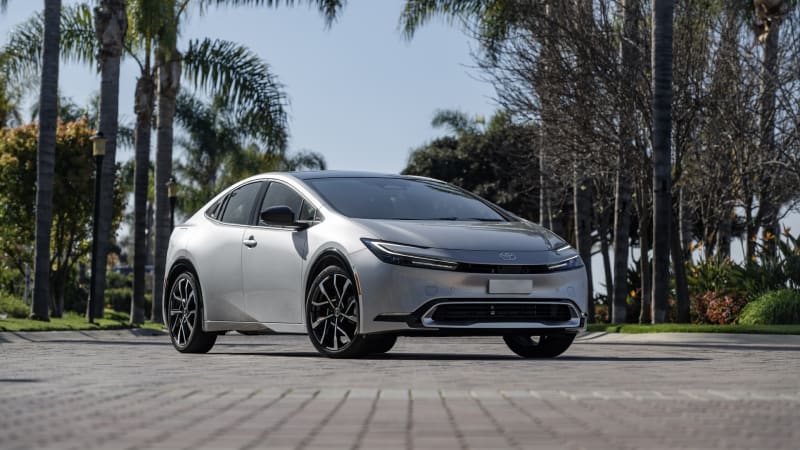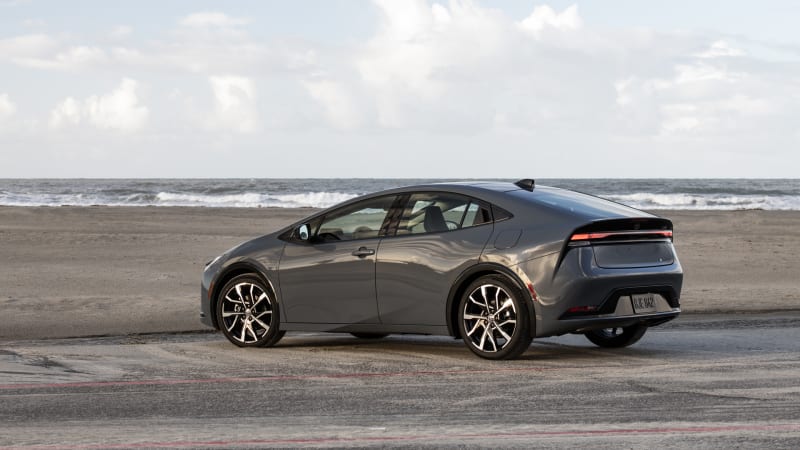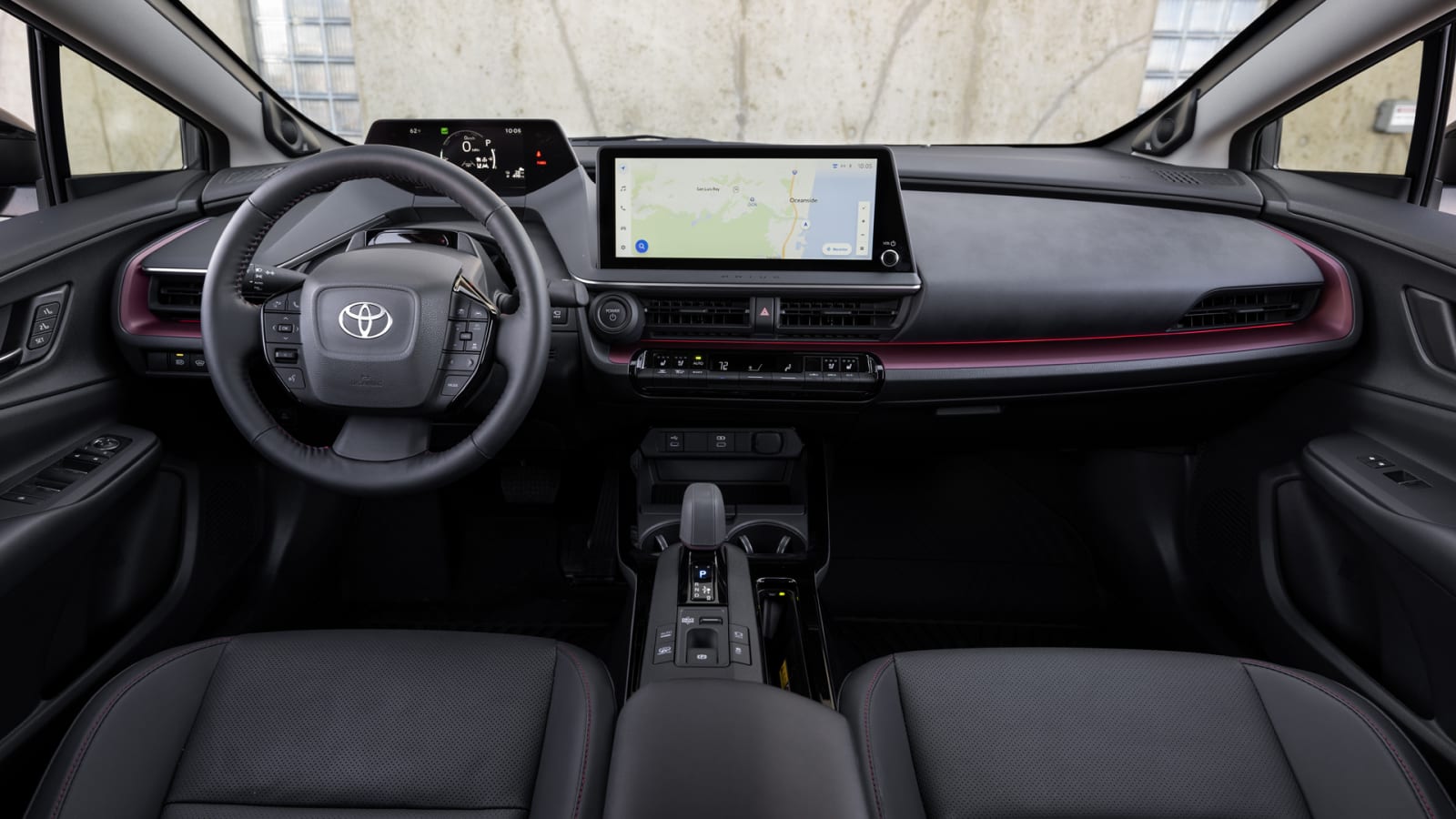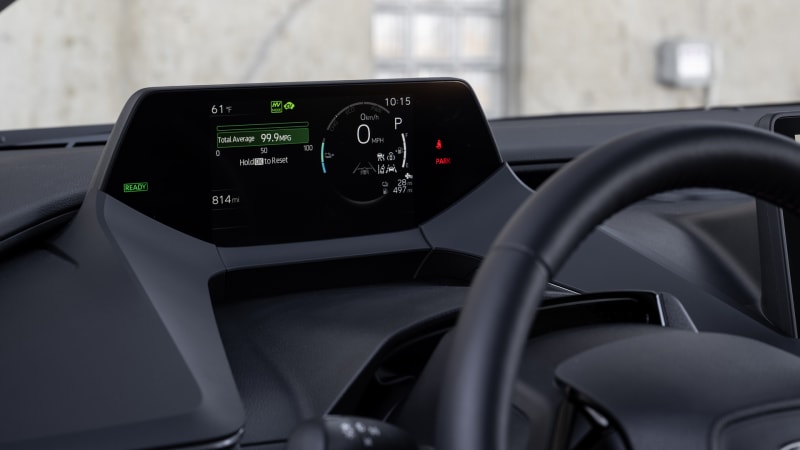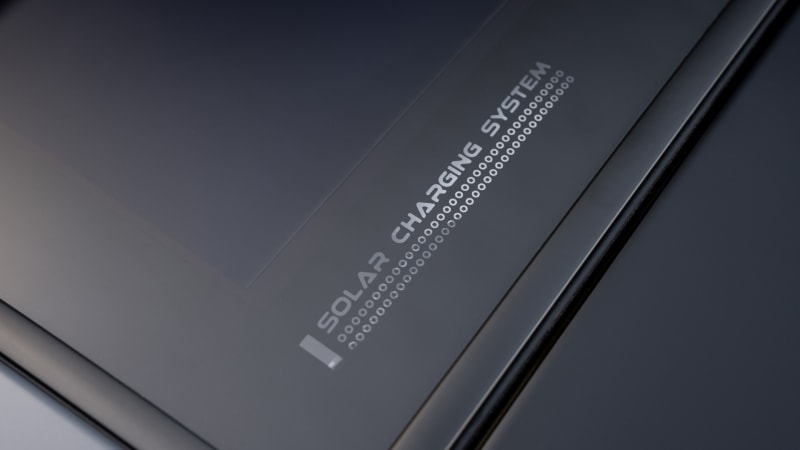CARLSBAD, Calif. – After coming to grips with a world in which a Toyota Prius is a cool, genuinely attractive car, it’s time to wrap your head around another doozy: the new 2023 Toyota Prius Prime plug-in hybrid is a genuinely quick car. It goes from 0-60 mph in 6.6 seconds, a pace comparable to V6-powered midsize sedans and entry-level luxury sport sedans not too long ago. The old one hit 60 in 10.2 seconds, a pace comparable to the snails dotting the soggy sidewalks here in rainy San Diego county.
Perhaps leading off with acceleration times when reviewing the definitive hybrid is an odd choice, but it’s just as representative of the Prius Prime’s stunning transformation as the sleek new looks. Much like the standard Prius, no longer is achieving max efficiency enough. Lay into the throttle, and the 220-horsepower Prime delivers a solid shove into your seat as its electric motor and gas engine combine in a smoother, more seamless manner than before. Our first full-throttle application was on a fairly significant grade, and the pace with which we got up to speed resulted in an exclamation of “whoa!” It’s quick on paper and feels it from behind its chunky, nicely contoured wheel. There’s also less noise and smoother gas engine engagement than both previous-generation Toyota hybrid systems and some that share its fifth-generation system thanks to an added balancing shaft.
This is the Prius Prime, though, so you can do most of your driving without the engine coming on at all. Put the car in EV mode, and the electric motor can solely power the car up to 84 mph for either 44 miles in the SE trim or 39 miles in the XSE and XSE Premium trim levels. The old Prime could only manage 25. Acceleration isn’t as vigorous without the engine lending a hand, but it also doesn’t feel overburdened. The engine will still kick in if conditions or throttle applications demand, but it’ll be rare.
The HV/EV Auto Mode will more readily engage the engine when going up grades, attempting 0-60 runs or when cruising on the highway when engines are at their most efficient and EVs more rapidly lose range. The Hybrid mode, which is engaged once the all-electric capacity is exhausted, basically turns the Prime into a regular Prius, albeit with a bit more electric oomph at your command. That’s not a bad thing as it’ll achieve 52 mpg combined without that all-electric capacity, or if you can’t plug in for some reason. Once you do, it’ll take 11 hours to recharge the battery using the same 120-volt outlet you’d plug in a TV or toaster, or four hours using a 240-volt outlet or home charger. That should be fine considering most people recharge overnight, but the Kia Niro PHEV with its slightly smaller battery size and more powerful onboard charger can get it done in less than three hours.
Speaking of Kia’s little electrified crossover, it’s the Prius Prime’s only competitor now that the Chevy Volt, Hyundai Ioniq and, to a lesser extent, Subaru Crosstrek Hybrid have all bit the dust. It’s certainly an imperfect comparison given the different body styles, but the two are similarly priced plug-in hybrids. The Kia has a bigger, more family-friendly interior and better tech, while the Prius provides more range and is far more powerful than the Niro PHEV, which is just as snail-like as the old Prime (though its six-speed automatic makes it feel quicker and more pleasant in terms of noise).
Besides the Prime relying more on its electric motor and slicing a half-second off the regular Prius 0-60 time, the Prime drives just as surprisingly well. The steering is rather numb, but there’s appropriate, consistent weighting and sufficient precision. Body motions are nicely controlled, and the ride is comfortable. Any thought that this quicker, sleeker new Prius is fun to drive should be checked at the door, but it’s not depressing, and that’s enough.
Visual differences are slight. There’s a nifty, new font for the Prime badge on the tail and unique wheels, 17-inch on SE and 19-inch on the XSE and XSE Premium. There are also subtle trim differences on account of the Prime only being available in those sporty SE trim levels that you can’t get at all on the standard Prius. Unlike other Toyota SE trim levels, though, there are no chassis changes made to sportify it apart from an additional front structural brace on the XSEs. Engineers say it was added because the 19-inch wheels imply a greater emphasis on performance.
Inside, the SE treatment includes a deep red trim on the dash and seats, which are upholstered in fabric in the SE and SofTex simulated leather in the XSEs. The Premium then gets a choice of roof: a dual-panel fixed-glass roof also available on upper regular Prius trim levels, and a unique-to-Prime solar roof. As the name implies, it’s capable of charging the battery while parked and can even supply power to auxiliary vehicle functions once underway. This represents a mere trickle of juice compared to the battery’s other sources, but why not take advantage of the free energy provided by our friendly neighborhood star?
Every Prime comes standard with Toyota’s new Traffic Jam Assist function, which allows for hands-free driving when on a highway under 25 mph. We didn’t get a chance to sample this because we didn’t get stuck in traffic (oh darn), but we’re also not sure how much better this is than Kia’s system that can accelerate, brake and steer for you with only a token finger on the wheel at a full range of speed.
The Prime gets the same Proactive Driving Assist included on the regular Prius that slows the car down when coming up to a slower car ahead or when approaching a turn. It feels like having adaptive cruise control or low-level EV regenerative braking engaged (the Prime does not offer that), and although the description of it sounds a bit HAL 9000, it works in a surprisingly natural manner. I only noticed it when approaching other cars, however, and not on some of the more engaging roads we were able to tackle this time around in the Prime versus the more mundane driving of the regular Prius’ press launch. That’s definitely not a bad thing. The rest of Toyota’s current Safety Sense active safety suite is onboard as well.
There’s no doubt that adding electric range and more power makes for an even better Prius than the one that has already so thoroughly impressed. It of course comes with a higher price tag, though, and there are no federal tax credits available. The SE starts at $33,445, including destination, and is basically equipped in between the regular Prius’ LE ($28,545) and XLE ($31,990) trim levels. The Prime XSE ($36,695) and XSE Premium ($40,265) are greater jumps with the regular Prius Limited topping out at $35,560. Technically, it could go higher with its optional all-wheel-drive variant, but that’s not available on the Prime.
Whether the Prime is worth that premium from a monetary perspective (versus a CO2 one) is entirely dependent on how much you’re going to plug in, how much you drive per day and how much you spend on electricity. It’s admittedly a very tough thing to calculate. EPA fuel cost estimates would indicate you’d save only about $1,000 in five years of ownership, but that’s a very loosey-goosey average. It can’t possibly account for individual situations. If we were to put forth a best-case scenario for getting the most bang for your Prime buck, it would be a round-trip commute below 40 miles, nightly charging and solar panels on the roof. That’s certainly not some pie-in-the-sky scenario, especially in California and the southwest in general.
Of course, there’s another reason to pay more for the Prius Prime: it’s quicker. Than a lot of other cars. How about that.
Related Video:


